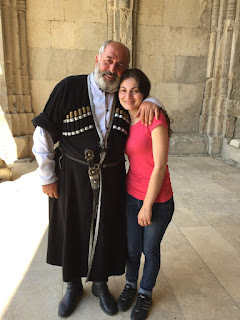June 9 to 20 2016 Russia - east to west
 |
| The Golden Horn bridge looms out of the mist |
I could never do justice to our journey across Russia's vast planes, marshes and mountains, not to mention its monumental cities and intriguing and, for us largely not understood, history. I'd be talking about attempting something in the proportions of 'War and Peace'! Suffice it to say it was exciting, engaging, challenging, intriguing and
memorable. From misty Vladivostok where we had a wonderful guide who walked and talked us through much of the city's history over the last century - its involvement in numerous wars, it's naval history and to the post soviet period when it opened its doors to visitors. We skinnied through old submarines, mounted the decks of a ship that was built for the Russian-Japanese war, lit candles in a church rebuilt after the Soviet period, strolled through a Friday farmers market in the centre of town which sold just about everything you could image (and some things we simply couldn't identify) - fresh and dried fish and meats, gruesome cuts of 'meat', cheese local and imported, fruit and vegetables local and imported, honey from many different trees and flowers, flowers, plants and herbs. There we bought fresh food for lunch as she, Anna, had invited us to her home for some Russian home cooking.
We were very fortunate to have had the opportunity to peak into the life of Vladivostok proper away from the tourist trail - off Broadway so to speak. For us the city was a little reminiscent of San Fransisco with its steep streets and stairs, busy harbour front, Golden Gate/Horn bridge shrouded in fog. Two days and we were off again.
 |
| Every carriage had a samovar on the boil |
 |
| Smoked salmon by the rails and by the bucketful |
The Trans Siberian train journey, which we started 11 June, was a wonderful adventure made just that little bit more challenging as we could speak and understand only a very few Russian words and the train stewards didn't speak any English. We managed - most of the time! We arrived in Irkutsk (Siberia, central Russia and part of the Asian continent), the so-called Paris of Russia, after 3 days of misty weather and soft grey skies which threw into stark relief the vast green meadows we passed as we traveled west, lush grass we wished we could have gathered by the armful and taken home, marshes and huge rivers, villages and shepherds cottages. We spent a lot of time just gawping out the window.
 |
| One cathedral to survive the Soviet era |
In Irkutsk we paused our trans-Siberian journey for a couple of days so we could explore the city and the nearby Lake Baikal which holds a quarter of the world's fresh water. It is enormous! During our time in Irkutsk we learnt a little about the region's, and in fact Siberia's, history from early and more more recent tribal pagan times through the introduction of Christianity in 17th century, the Soviet period in the 20th century and finally to the present time of renewal. We walked through one of the villages on the banks of Lake Baikal, took a chair lift to a high vantage point to peer into the distance trying to see the distant shores - we couldn't, but we got the chance to sit on a rocky spire when once the villagers sent people accused of a crime to spend the night exposed to the elements. If they were alive in the morning they were deemed innocent!
Two days of walking and our feet were very happy to mount the steps of the train for the next leg of the train journey west to Moscow 4 days away.
 |
| Lake Baikal |
As an aside, we ate well along the entire route - self-catering for breakfast and lunch with packet soup, salami and cheese bought at the markets, fruit, pastries and, what we hoped were, hard-boiled eggs bought in a point and nod with fingers crossed at whistle stops along the way.
The scenery was beautiful - forests of conifers, birch, beech, willow, poplars, wild flowers of all descriptions including hollyhocks, wild roses, lupin, lilacs. And the colours - white and all shades of pink, purple, mauve, blue, yellow!
Charging batteries for our various devices was a bit of a challenge, but we found a 220W outlet in the dinning car and sat over a glass or two of wine whiling away the time as our various things recharged. Oh, that life could always be as complicated as that!!
 |
| Bogey tappers! testing for cracks |
It was a memorable journey peppered with funny and not so funny moment like having to dash off the train at a small station in the middle of nowhere in the wee hours for just that - the toilets on the train were locked approaching and while at stations and having just woken I simply couldn't wait!! Lindsay stood guard at the door of the train, not that he could have done anything if the train had started to pull out, but he had an anxious eye on his watch - Russian trains leave and arrive at precisely the scheduled time to the second! It was a hurried and hilarious pit stop!
We rolled into Moscow at 4am two days before the summer solstice so the sun, and us, had been up for some time, and staggered onto the platform with our way-to-heavy luggage packed for Arctic and Mediterranean climates - plus those ..%#*^.... gumboots! And so we started another highpoint of our journey ...........
I am writing this from Gudauri a ski resort nestled in the very heart of the Greater Caucasus mountains but that will have to wait until later. We still have Moscow and Armenia to explore.





































